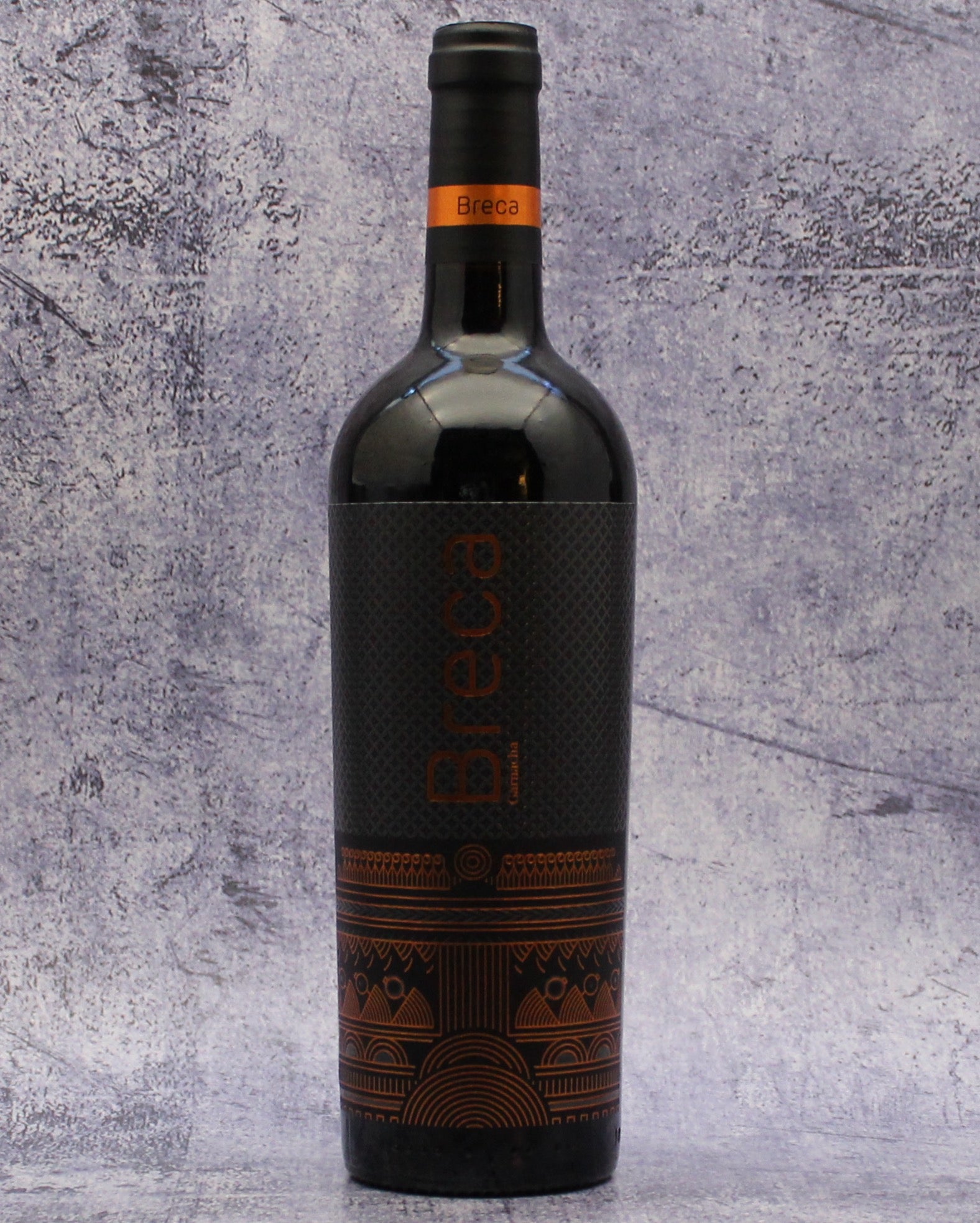From: D.O. Calatayud, Spain
Varietal: Garnacha
Taste & Critical Acclaim: This wine offers aromas of rich black fruit with hints of black pepper. Its distinct minerality reflects the region's varied soil types. On the nose, there's a delightful mix of spicy red and black fruits combined with undertones of sandalwood, dried flowers, and herbes de Provence, complemented by chalky, mineral-like notes. The palate reveals flavors of juicy boysenberry, cherry cola, and candied violet, while its texture showcases chalky tannins, leading to a ripe and juicy finish. Notably, this Garnacha has received praise from critics: JD93 from Jeb Dunnuck, JS92 from James Suckling, and V91 from Vinous.
JD 93 Jeb Dunnuck
I loved the nose on the 2019 Breca, which is loaded with spicy red and black fruits as well as notes of sandalwood, dried flowers, herbes de Provence, and some chalky, mineral-like nuances. Beautiful on the palate as well, this medium to full-bodied, elegant, balanced, straight-up gorgeous Garnacha...
JS 92 James Suckling
A bold and ripe garnacha with some nicely baked red cherries and strawberries, with some white pepper spices. Nice texture on the medium- to full-bodied palate, showing close-knit, chalky tannins and a ripe, but juicy finish.
V 91 Vinous
Inky ruby. Expressive red and blue fruit, spicecake and woodsmoke scents are joined by an emerging floral pastille quality. Juicy, penetrating boysenberry, cherry cola and candied violet flavors deepen through the back half. Shows very good depth and energy, finishing sweet, spicy and long, with polished tannins adding gentle grip. Raised in large used oak casks and concrete tanks.
Pairing: This wine would pair well with hearty local dishes such as Ternasco Asado (young, juicy lamb meat), Jamon de Teruel (cured ham from Teruel), and Rabo de Toro (bull tail stew). Other options include pulled pork, BBQ ribs, Korean BBQ, grilled burgers, kebab, meatballs, gyro’s, mild to medium spiced pork and rice dishes, or grilled/baked sausages or portobello mushrooms over polenta or Spanish rice. The recipe we’re sharing below incorporates chicken, mushrooms, and onions in a dish as comforting as French onion soup but with less time and effort. This combination plays to the wine’s fruit and low tannin character, showing off those red fruit and spice notes and leaning into comfort.
Skillet Chicken With Mushrooms and Caramelized Onions
By Yasmin Fahr
About. Garnacha, though most well-known for its French name Grenache, was originally cultivated millennia ago in what is now the autonomous province of Aragon. Garnacha was first spread to southern France and Italy by the medieval Spanish Kingdom of Aragón, which had holdings across the Mediterranean. Due to its original cultivation in Spain, the oldest clones worldwide of the Garnacha variety are planted extensively in D.O. Calatayud and nearby D.O. Campo de Borja.
Bodegas Breca’s philosophy is to highlight the unique characteristics of the Garnacha from Calatayud. Calatayud is an arid and mountainous region three hours northeast of Madrid. Bodegas Breca is located on the outskirts of the town of Munebrega, which for many centuries was a Celt-Iberian city that resisted Roman occupation for decades until the arrival of Scipio Africanus on the Iberian Peninsula. Viticulture flourished under the Romans, but in the 20th century, cooperatives dominated the winemaking scene in Calatayud. Jorge Ordóñez, founder of Bodegas Breca, was the first to introduce D.O. Calatayud into the United States.
Vineyard Bodegas Breca owns and leases vineyards exclusively of the original clones of Garnacha on the Sierra de Pardos and Sierra de Peña Blanca. These vineyards, planted between 1900 and 1975, are all head trained and dry farmed.
Breca, the flagship wine, is produced from a variety of tiny plots, each of which is only 1.5 ha. on average because of the mountainous terrain. The vineyards used for Breca are planted between 850M and 1,050M above sea level. These altitudes are vital for Breca – they are responsible for 60˚F temperature swings (40˚F-100˚F) during the growing season. These conditions are perfect for Garnacha, a variety that requires warm conditions to ripen fully due to its long vegetative cycle. At the same time, the cold nights slow the ripening process, maintaining acidity and elegant aromatics.
Along with its altitudes, Calatayud’s soils are its distinguishing feature. The plots used for Breca vary from black slate (like in Priorat) to gray slate, to iron-rich red slate, limestone, and red clay intermixed with decomposed slate and quartz. Each soil type produces a drastically different wine. The variety of soils in the final wine lends a distinct complex minerality to Breca.
The grapes are hand-harvested when they have reached phenolic ripeness and sorted at the winery. They macerate and ferment with indigenous yeast in 5,000L open-top stainless steel vats. The maceration only lasts eight days as the blueberry-sized grapes do not require much extraction. The wine is pressed extremely slowly over twelve hours in a vertical basket press to avoid the extraction of bitter phenolic compounds. It ages twelve months in these large format barrels and is bottled unfined and unfiltered.
Over 150 small vineyard sites are planted in the foothills of the Sierra de Pardos and Sierra de Peña Blanca surrounding Munébrega, in the southern part of DO Calatayud.
Varietal
This wine, in a nutshell. Breca is an artisanal wine produced from the original Garnacha (Tinta de Aragón), which was first cultivated in Aragón in the 7th century and spread around the Mediterranean by the Kingdom of Aragón. Calatayud is Spain's highest altitude DO for Garnacha, which results in drastic diurnal shifts of up to 50°F in the growing season. This altitude and the region's slate soils impart a unique freshness and minerality to the Garnacha's red fruit profile.
Origin. Multiple old mountain vineyards planted in low density without terracing.
Year(s) Planted: 1925-1990
Viticulture. Traditional dry-farmed viticulture. Practicing organic gobelet trained vines. In challenging years, the winery sprays with copper sulfate once per growing season.
Terroir. Soils from the Miocene are rich in iron, and as they move from highest to lowest altitude, they include red slate, gravel, and limestone & clay loam, respectively. There is also an important component of sand.
Climate. Continental Mediterranean climate with cold winters, hot summers, and drastic temperature fluctuations between day and night that can reach 60˚F. Vines self-regulate production levels based on hydric stress levels.
Vinification. Hand-harvested in small 10kg boxes. Destemmed whole berries are transferred to 5,000L open-top stainless steel vats. Fermentation starts with a pied de cuve, and maceration lasts for no longer than eight days. The grapes are gently pressed over 6-8 hours. Primary fermentation completes, and malolactic fermentation begins spontaneously in 500L & 600L French barrels from 2010.
Elaboration. 18 months sur in French oak puncheons and demi-muids (500-600L barrels, respectively).

